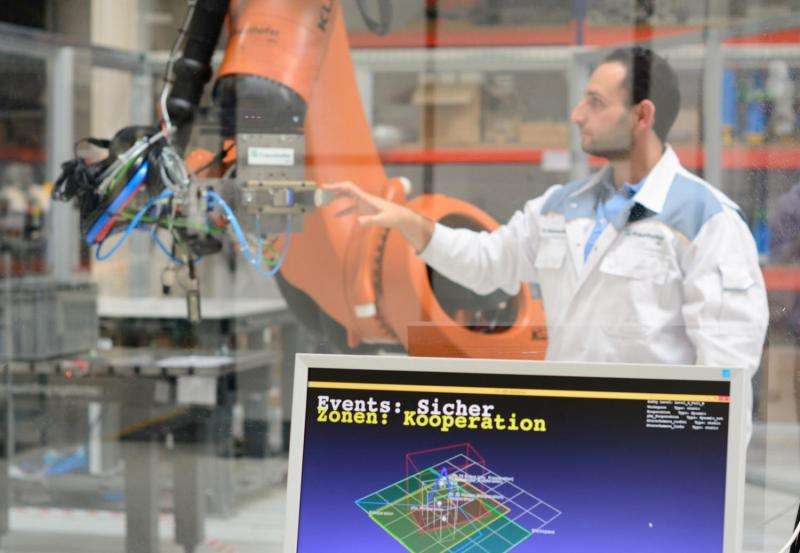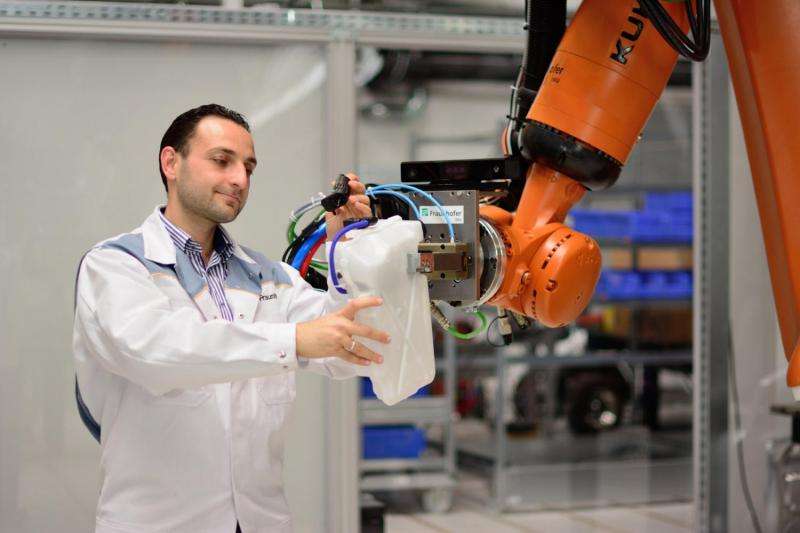New safety technology enables teamwork

Until now, heavy-duty robots have always been housed in separate work areas to safeguard factory employee safety. Researchers at Fraunhofer want to change that with an ingenious security concept and intelligent robot control. This technology will enable people and robots to collaborate as a team. The researchers will present this concept at the Hannover Messe from April 24-28 (Hall 17, Booth C18).
Heavy-duty robots in manufacturing, which can easily lift components weighing 200 kilos, swivel around quickly or move with a speed of up to two meters per second, pose a danger to human lives. To rule out any potential risk to employees, these steel colleagues have so far operated in a separate environment. However, cooperation would be much more efficient if humans and robots worked side by side, without protective barriers. But how does one ensure safety? The Fraunhofer Institute for Machine Tools and Forming Technology IWU has now come up with a solution to this problem.
The experts at Fraunhofer IWU have developed a differentiated safety concept that begins by defining different levels of collaboration. The more intensive the interaction between human and machine, the higher the level and more stringent the safety regulations. For example, if the robot needs to hand over a component to an employee, it moves as slowly and carefully as determined for this level. When working on separate tasks at a safe distance from each other, robots can work at full speed. Fraunhofer researchers have defined a total of four levels of collaboration.
These levels are supplemented by dividing collaborative work areas into spatial zones. Each zone specifies how close humans and machines are to each other. At the lowest level, there are only two zones; a green and a red zone. If the employee is at a safe distance from the robot, it indicates a green zone and the robot can work at full speed. As soon as an employee approaches, a red zone is activated and the robot immediately stops working. In instances where teamwork is required – for instance to swap components or tools – then a yellow zone of cooperation is added. The heavy-duty robot now moves carefully and at low speed.

Cameras, sensors and intelligent algorithms
In order for the robot to respond properly, it must know the employee's position and route at all times. It can do this with the help of several cameras that enable it to "see." Two cameras are placed above the work area and provide a view of the entire work space. They also show the employee's current location. An additional camera sits on the "head" of the robot and captures the close-up area. It helps the robot recognize the face, hand or component in the employee's hand.
A row of sensors supplement the cameras. To prevent a collision, they register parameters such as the robot's position, acceleration and power as well as the employee's position and movement. The intelligent algorithms developed by Fraunhofer IWU help evaluate all this data. They ensure that the robot's behavior is constantly aligned with all the safety regulations based on the task and situation at hand.
"Our system is already fully functional and has been tested in the lab. This year, the goal is get the trade association to test an application and enable its implementation in the industry," says Prof. Matthias Putz, Director of Fraunhofer IWU.
Teamwork in virtual reality
This technology has already been tested in virtual reality. Using VR goggles, users can virtually experience teamwork with the machine. The system runs at full speed in virtual reality mode. "VR technology is thus an excellent way to realistically test the interaction with a robot," says Prof. Putz. Fraunhofer experts want to refine the system in the near future. "Soon it should be able to adjust to the employee's behavior by analyzing the person's movements," explains Putz. "In addition, we are working on gesture recognition, which will enable an employee to control the steel colleague with hand movements. For example, using a hand gesture to ask the robot for a tool."
Provided by Fraunhofer-Gesellschaft





















